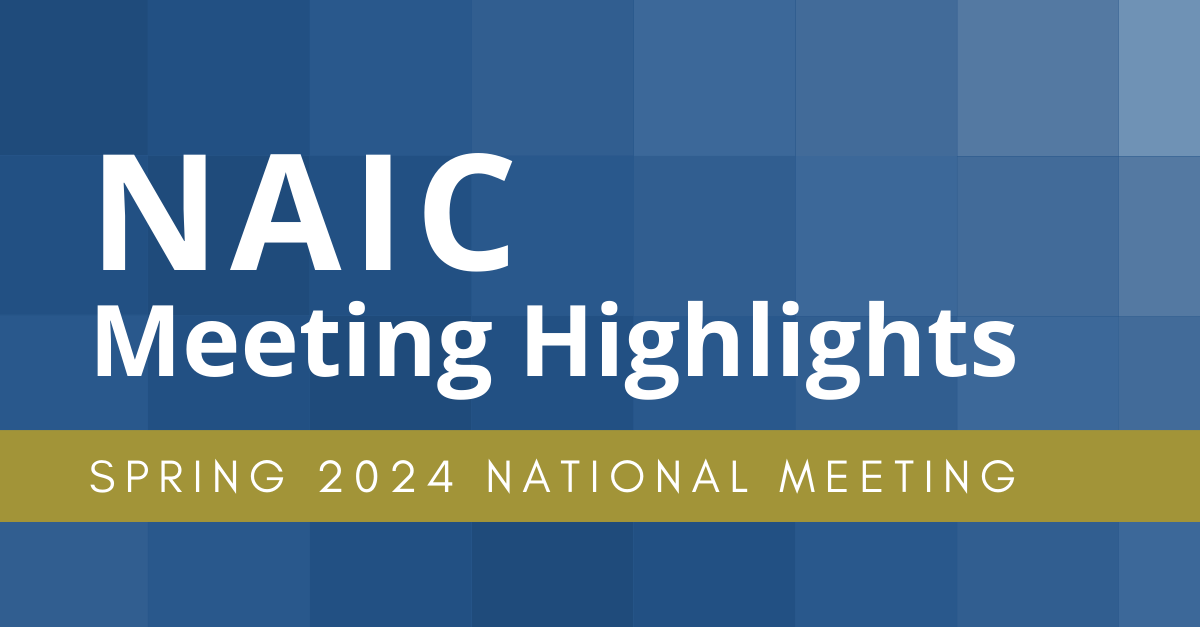April 19, 2024
NAIC Spring 2024 Meeting Highlights
Johnson Lambert LLP is dedicated to keeping you informed of changes adopted by the NAIC. In this edition, you’ll find a summary of statutory accounting adoptions made by the Statutory Accounting Principles Working Group (SAPWG) during the Spring National Meeting that will impact 2024 statutory basis financial statements and the latest updates on activities proposed or adopted by the Big Data and Artificial Intelligence Working Group, the Cybersecurity Work Group, and the Climate and Resiliency Task Force.
Statutory Accounting Updates
| Ref # | SSAP No | Title | Revision Description | Effective |
| 2023-29 | Annual Statement Instructions | IMR/AVR Preferred Stock | No change to statutory accounting. Recommends changes to the Annual Statement Instructions to clarify that realized gains and losses on perpetual preferred stock and mandatory convertible preferred stock should follow the same concepts that exist for common stock in reporting through the asset valuation reserve (AVR). The proposed instruction changes will be considered by the Blanks Working Group for year-end 2024. | N/A |
| 2023-30 | 97 | Admissibility Requirements of Investments in Downstream Holding Companies | Clarifies the language in SSAP No. 97 – Investments in Subsidiary, Controlled and Affiliated Entities, paragraph 24, regarding audited GAAP financial statements and admissibility for downstream non-insurance holding companies to align more closely with existing language in paragraphs 26 and 27 describing the look-through methodology. | 03.16.24 |
| 2023-28 | 21R | Collateral Loan Reporting | Entities are required to report collateral loans on Schedule BA, disaggregated by type of collateral that secures the loan. Adds new disclosure of total collateral loans by collateral type, and whether the collateral loan is admitted or nonadmitted. | 12.31.24 |
| 2019-21 | 21R | Principles-Based Bond Project & Residual Interests | Directs all debt securities that do not qualify as bonds to accounting guidance in SSAP No. 21 Other Admitted Assets, and reporting on Schedule BA. Incorporates a new measurement method, effective yield with a cap, for all residual interests as well as a practical expedient to allow the cost recovery measurement method. Early adoption is permitted only for the residual guidance. | 01.01.25 |
| 2022-14 | 93R, 94R, 34, 48 | New Market Tax Credit Project | Expands SSAP No. 93 – Low-Income Housing Tax Credit Property Investments to include all tax credit investments, regardless of structure and type of state or federal tax credit program, and SSAP No. 94 – Transferable and Non-Transferable State Tax Credits to include both purchased state and federal tax credits. Consistency revisions were applied to SSAP No. 34 – Investment Income Due and Accrued and SSAP No. 48 – Joint Ventures, Partnerships and Limited Liability Companies for the new tax credit guidance. | 01.01.25 |
Rejected ASUs
The following FASB ASUs were rejected by the SAPWG during the Spring, 2024 meeting:
- ASU 2023-03 – Presentation of Financial Statements (Topic 205), Income Statement—Reporting Comprehensive Income (Topic 220), Distinguishing Liabilities from Equity (Topic 480), Equity (Topic 505), and Compensation—Stock Compensation (Topic 718) Amendments to SEC Paragraphs Pursuant to SEC Staff Accounting Bulletin No. 120, SEC Staff Announcement at the March 24, 2022 EITF Meeting, and Staff Accounting Bulletin Topic 6.B, Accounting Series Release 280 – General Revision of Regulation S-X: Income or Loss Applicable to Common Stock
- ASU 2023-04 – Liabilities (Topic 405) – Amendments to SEC Paragraphs Pursuant to SEC Staff Accounting Bulletin No. 121
Big Data and Artificial Intelligence (H) Working Group
The Big Data and Artificial Intelligence Working Group discussed the group’s project plans for 2024, which includes a collaboration between NAIC staff and the Center for Insurance Policy and Research (CIPR) to continue analyzing existing artificial intelligence (AI) and machine learning (ML) survey responses. The Working Group also discussed that developing the health insurance AI/ML survey has begun. The development group, comprised of representatives from 17 states, will meet with insurers in a pilot study to solicit feedback on the initial survey design. The Working Group expects survey design results to be reported prior to or during the NAIC’s 2024 Summer National Meeting.
Surveys covering the use, planned use or exploration of use by automobile, homeowners and life insurers (excluding annuities) have concluded with notable results. Of the companies that responded to the surveys, more than half use, plan to use, or plan to explore the use of AI/ML. Although, life insurers (58%) surveyed reported significantly less use, plan to use, or plan to explore the use of AI/ML when compared to automobile insurers (88%) and homeowner insurers (70%). Data from the most recent life survey indicates that of the insurers already using or planning to explore the use of AI/ML models, they are primarily using it for marketing and underwriting purposes but also use it for pricing, risk management and other reasons.
Cybersecurity (H) Work Group
The Cybersecurity Working Group adopted the Cybersecurity Event Response Plan (CERP), which is intended to support state insurance departments in their response following notification of cybersecurity events from regulated insurance entities. The CERP is focused on primary actions and considerations, and may require tailoring to suit a particular state insurance department’s needs. As cybersecurity laws and regulations vary from state to state, the CERP does not specifically address which types of events must be reported. Regulators should refer to the reporting requirements specific to their state. The CERP is a voluntary plan available for state insurance departments. Insurance companies may review the CERP to gain an understanding of what to expect after reporting a cybersecurity event to the regulator.
Climate and Resiliency (EX) Task Force
The Climate and Resiliency Task Force heard a presentation on Innovating For Climate Risk and focused on the challenges and opportunities facing the insurance ecosystem in its efforts to manage climate risks. Natural science trendlines show climate risks are rising. Sea levels, sea temperatures and the extent of wildfires in the United States, among others, are all trending upwards. Further, the protection gap has widened over the last fifty years, driven by climate risks, and data shows an increasing government role (e.g. California FAIR Plan and Florida Citizens Property Insurance Corporation). The presentation highlighted innovative initiatives emerging at local levels to address climate issues and encouraged creating more space for public and private partnerships to develop scalable impacts.
If you have any questions about the Spring National Meeting update you can contact us here.




